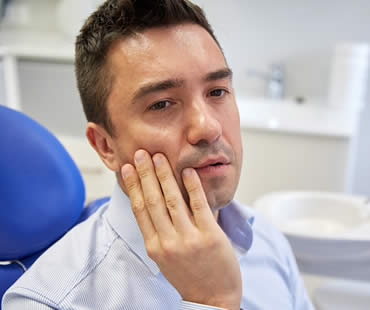
Teeth that cause you to be embarrassed about your smile may be hidden using a popular cosmetic dentistry technique called veneers. Broken, chipped, discolored, or misaligned teeth can easily be hidden with this long-lasting dental solution.
Veneers are very thin shells, usually made of durable porcelain, placed over your teeth to hide the flaws. It is a simple process for your dentist to attach them to your teeth, and you and your dentist can even choose the color of your veneers for the most natural and appealing look. The process is pain-free and does not require lots of time at your dentist’s office. Veneers feel like regular teeth and do not cause irritation of your gums.
One of the greatest things about veneers is that the porcelain resists stains, so you can eat and drink whatever you would like without avoiding items that are known to discolor teeth. Caring for veneers does not require anything additional to your normal oral hygiene routine. Proper maintenance will help keep your veneers looking great and your teeth healthy.
Finding a dentist to do your veneers is usually easy. Many dentists practice this technique, it is just a matter of inquiring to find out which ones provide the service and determining who you are most comfortable with to do your dental work. You should make sure that the dentist you choose is experienced and qualified in providing dental veneers. Asking for before and after photos of other patients with veneers is a good idea too.
Once you have chosen a dentist and decided together that veneers will be helpful in your case, you will be on your way to a beautiful smile.
Our dental office is located in Ottawa

Some people would rather endure tooth pain than have their wisdom teeth extracted during surgery. Most of the time, fears are based on irrational tales that people read on the internet or hear from others. The truth is that wisdom tooth surgery is extremely common and most oral surgeons perform them every day without complications. The best way to overcome fear is to learn more about the procedure and recovery.
Procedure:
Extracting wisdom teeth involves opening the gums above the tooth and removing any bone that is blocking the tooth’s ability to erupt. The tissue will be separated to be able to remove the tooth, sometimes even in pieces if necessary. In some cases when bone is removed, a bone graft is needed to replace it. After the procedure is complete, stitches will be placed that will dissolve with time. If this sounds awful, remember that patients don’t feel any pain during the procedure due to sedation and usually don’t even recall anything that happened during treatment.
Recovery:
There are some common outcomes to be expected after wisdom tooth extraction, all of which usually subside within a few days as long as you follow your surgeon’s instructions. Have someone accompany you to and from the appointment so they hear the recovery directions and so you don’t drive. Afterwards, you will be given gauze to bite on at the extraction site. Bite gently on the gauze and change it frequently. Avoid lying flat on your back because bleeding may increase. If you experience swelling, hold ice packs on the outside of your cheeks for the first day. Eat soft foods and avoid using a straw for the first few days, and try not to touch the area with your fingers or tongue. Do not smoke for at least 24 hours after oral surgery. If you follow all these guidelines and any others that your doctor provides, there are few risks and no reason to be afraid of wisdom tooth extraction.
If you live in the Ottawa area contact us today

Finding the right dentist is an important decision because it’s a healthcare relationship that can last a lifetime. The need for dental care starts around age one and continues through senior adulthood. For routine dental care, you might choose to see a family dentist or a general dentist. Although there are some similarities, the two types of dentists have some unique aspects.
Services:
Both types of dentists offer routine services that are common to oral health care. This includes examinations, cleanings, x-rays, and fluoride treatments. Instructing patients about dental hygiene such as proper brushing and flossing is part of most family and general dentistry practices as well. Poor oral care can cause decay, infections, gum disease, or other problems. Both types of dentists also offer treatment for when problems arise, such as dental fillings.
Patients:
General dentists often cater to patients in a certain age range, but family dentists provide treatment for patients of all ages. Infants, children, adolescents, adults, and seniors are all able to seek oral health care from a family dentist. Each age group has unique needs and issues, but family dentists are skilled in caring for everyone.
Specializations:
Since they see all ages of patients, family dentists are skilled in a wide variety of procedures. They are able to diagnose and treat many oral health conditions, including gum disease and oral cancer. Typical procedures they offer include tooth extractions, root canals, fillings, crowns, bridges, and sealants. Some are able to perform specialty services like implants and veneers. Many patients enjoy being able to obtain treatment from their family dentist without having to see a specialist.
Benefits:
In addition to the benefit of getting a variety of treatments in one location, family dentists are also able to provide ongoing treatment for all household members. Children and parents go to the same location and can even request back-to-back appointments. Everyone learns the same dental care techniques that they can practice at home together. Family dentists encourage every member of the family to take pride in their oral health.
If you need a dentist in Ottawa contact us today

If you are about to undergo root canal treatment to save a compromised tooth, your oral surgeon or dentist will likely provide you with a list of aftercare instructions. It is vitally important that you follow these recommendations to avoid complications and ensure the success of your endodontic treatment.
There are a few tips you can follow to speed up your recovery time, promote healing, and prevent serious dental problems and infections following root canal treatment:
- Do not chew on the treated side of your mouth until all of the numbness from the anesthetic has worn off completely.
- To manage swelling, apply an ice pack or bag of frozen peas on the treated area for thirty minutes. Repeat once an hour for about fifteen minutes each time until swelling subsides.
- For several nights after treatment, keep your head elevated while sleeping.
- Gently rinse your mouth with warm salt water regularly for the first few days after root canal treatment.
- Refrain from smoking for a minimum of 24 hours and try to curb tobacco usage as much as possible during the healing period.
- Avoid strenuous physical activity or exercise for 48 hours after your root canal procedure.
Contact your dentist immediately if you experience any excessive swelling or pain, the appearance of a rash or hives, or a return of original symptoms. By listening to the recommendations of your dentist, and following these extra tips, you can assure yourself the best chance of a rapid and complication-free recovery from root canal treatment.
Schedule your appointment at our Ottawa dental office

A variety of factors can cause your teeth to become dark and dingy. Smoking or chewing tobacco, drinking wine, coffee or tea, eating pigment intense foods, too much fluoride, or trauma to the tooth can all cause your teeth to discolor and lose their shine. The good news is cosmetic dentistry offers several options to return your teeth to their natural whiteness:
- Professional teeth whitening can be completed in as little as one office visit and can lighten your teeth as much as ten shades. This type of whitening mainly treats surface stains and can last several years with careful maintenance.
- Dental veneers are a better option for teeth with internal stains that are resistant to professional whitening. The placement of veneers involves roughing up the surface of the tooth and then applying an extremely thin porcelain or composite veneer that bonds to the surface of the tooth. With care, dental veneers can last as long as ten years.
- For individual teeth that have changed color due to damage or trauma, composite bonding is an excellent option. This procedure involves the use of a tooth-colored bonding material to cover the surface of the tooth and match it to the color of the surrounding teeth.
If you suffer from a dark or discolored smile and want to restore it to bright and white, cosmetic dentistry may be the answer to your concerns. Schedule a consultation with a qualified cosmetic dentist to find out which treatments would best suit your needs and allow you to once again face the world with a beautiful, white smile.
If you need a dentist in Ottawa contact us today

Today’s cosmetic dentistry offers an extensive array of treatments and procedures to help restore a beautiful and healthy smile. While you may never have considered cosmetic dental procedures as a solution to your dental concerns, there are quite a few reasons you may want to consider for seeking cosmetic dental treatment:
- Crooked, cracked or decayed teeth can be corrected through bonding, crowns, and veneers, returning your smile to its once vibrant and healthy appearance.
- Decay and disease can cause you to lose teeth, creating gaps that hollow your face and age your appearance. Cosmetic dentistry offers a wide variety of options such as dental implants for restoring missing teeth, keeping your smile and face younger looking.
- Teeth that have yellowed or discolored over time due to wine, tobacco or staining foods can be lightened up to ten shades with professional teeth whitening treatments performed by a qualified cosmetic dentist.
- “Horsey” looking teeth or “gummy” smiles can be corrected through gum re-contouring or restructuring to create a younger, more appealing smile.
- Misaligned or gapped teeth can be straightened through orthodontia such as Invisalign that is virtually invisible and pain and hassle-free.
Some cosmetic treatments may be offered by your family dentist, but you may want to consider a consultation with a qualified cosmetic dentist to find out more about the full array of treatments available to address your cosmetic dental concerns. Many procedures are quick and painless, and can be combined with other cosmetic treatments to achieve the results you desire. With the help of cosmetic dentistry and proper oral care, you can be assured a confident, more perfect smile.
If you need a dentist in Ottawa contact us today







